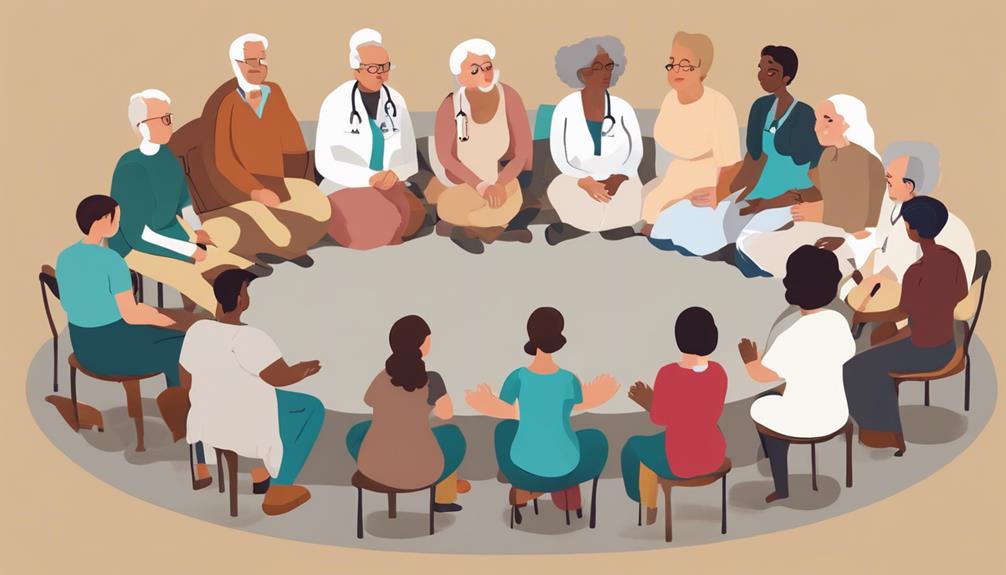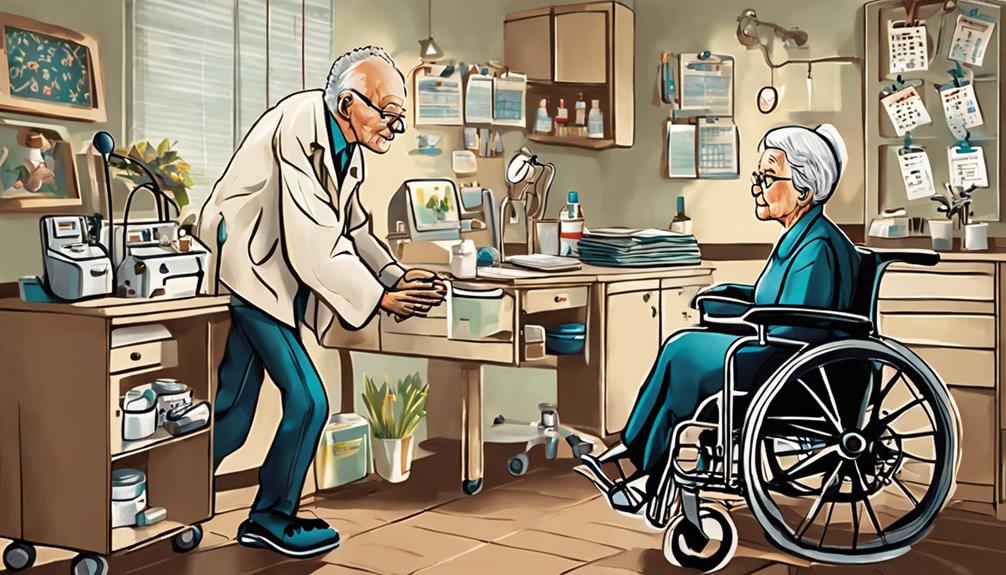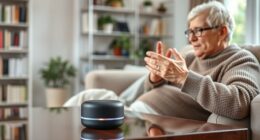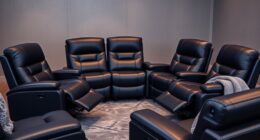To regain independence after a fall, older adults need to be aware of risk factors and focus on physical fitness. Strengthening muscles and addressing limitations are crucial. Building confidence through exercise can help overcome the fear of falling. Creating a safe home environment by selecting non-slip flooring, installing proper lighting, and adding grab bars is important. Participating in physical activities to improve balance and strength is advised. It is essential to promptly seek medical assistance for personalized recovery plans. Emotional healing is also crucial, seek support from family and friends. Engaging in community activities for social connections is beneficial. Nutrition also plays a role in the recovery process. Long-term strategies include exercise, safe living environments, and use of assistive devices. There are more tips available for a successful recovery.
Key Takeaways
- Engage in physical therapy for balance and strength.
- Create a safe home environment with proper lighting.
- Utilize assistive devices for stability and support.
- Review medications for potential side effects on balance.
- Maintain a clutter-free space for easy movement.
Common Risk Factors for Falls
Understanding the common risk factors for falls in seniors is essential for taking proactive measures to prevent accidents and promote recovery. Seniors are at a higher risk of falling due to various factors such as physical injury, cognitive impairment, and even weather conditions. Around one-third of seniors will experience a fall in their lifetime, making it important to address these risks.
Improving physical fitness through exercises can greatly reduce the impact of these common risk factors. By identifying and addressing issues like physical limitations, seniors can work towards rebuilding their independence after a fall. It's important to be aware of these risk factors and take steps to mitigate them to guarantee the safety and well-being of seniors.
Through a combination of exercise, awareness, and preventive measures, falls can be minimized, and seniors can maintain their independence and quality of life.
Overcoming Fear of Falling

To conquer the fear of falling, seniors can gradually increase their confidence by engaging in strength exercises and balance programs. When we build our physical strength and improve our balance, we also strengthen our belief in our abilities, reducing the fear that holds us back.
Seniors must address this fear head-on to regain their independence and lead an active lifestyle. By participating in these programs, we not only enhance our physical capabilities but also boost our mental resilience.
Overcoming the fear of falling is important for seniors to maintain mobility and stay engaged in the activities they love. Through consistent practice and dedication to these exercises, we can greatly reduce the anxiety surrounding falls.
Let's take the first step towards regaining our confidence and independence by committing to these strength and balance programs. Remember, each small improvement brings us closer to a life free from the fear of falling.
Preventing Falls at Home
To prevent falls at home, it's essential to make safe flooring choices and guarantee proper lighting solutions.
By choosing non-slip flooring materials and keeping floors free of clutter, we can decrease the risk of tripping and falling accidents.
Additionally, well-lit hallways and staircases can enhance visibility and help seniors navigate their homes safely.
Safe Flooring Choices
When selecting flooring for your home to prevent falls, opt for non-slip options like cork, rubber, or textured vinyl. These choices provide stability and reduce the risk of slipping, important for senior living and fall prevention.
Additionally, carpets with low pile height and firm padding offer traction and cushioning, enhancing safety and health. It's important to avoid high-gloss or slippery surfaces such as polished marble or hardwood floors as they can increase the likelihood of accidents.
Consider installing grab bars or handrails in areas with smooth flooring for extra support, aiding in physical activity and recovery.
Regularly inspect and maintain your flooring to address any loose tiles, worn carpets, or uneven surfaces to eliminate tripping hazards and promote safety at home.
Proper Lighting Solutions
Proper lighting solutions play an important role in enhancing safety and preventing falls at home for seniors. Adequate lighting can significantly reduce the risk of accidents by illuminating potential hazards. Installing energy-efficient LED lights in key areas such as staircases, hallways, and entryways can help prevent tripping. Dim lighting can make it challenging for seniors to navigate their surroundings safely, emphasizing the importance of well-lit spaces. Night lights strategically placed in hallways and bathrooms can assist seniors during nighttime movements, further minimizing the risk of falls. Ensuring proper lighting throughout the home is essential for creating a secure environment that promotes independence and well-being.
| Proper Lighting Solutions | Benefits | Key Areas |
|---|---|---|
| Reduce risk of falls | Enhance visibility | Staircases |
| Illuminate hazards | Prevent tripping | Hallways |
| Energy-efficient LED lights | Aid nighttime movements | Entryways |
Importance of Physical Activities

Engaging in physical activities plays an essential role in aiding seniors' recovery process after a fall by enhancing balance, muscle strength, and eye-tracking ability. Seniors benefit greatly from staying active post-fall, as it helps improve their overall well-being and promotes independence. Here are some key reasons why physical activities are vital for seniors during fall recovery:
- Improving Balance: Exercises focused on balance can help seniors regain stability and prevent future falls.
- Enhancing Muscle Strength: Strengthening muscles through physical activities can assist seniors in regaining mobility and independence.
- Boosting Eye-Tracking Ability: Engaging in exercises that enhance eye-tracking ability can improve coordination and spatial awareness.
- Promoting Overall Well-being: Regular physical activity not only aids in recovery but also contributes to seniors' overall health and quality of life.
- Fostering Independence: By participating in physical activities, seniors can regain confidence in their abilities and maintain their independence.
Home Safety Checklist

Our focus shifts to ensuring home safety through a thorough checklist tailored to protect seniors from potential hazards.
To begin, installing grab bars in critical areas such as bathrooms and hallways can greatly reduce the risk of slips and falls. These bars provide stability and support, especially when moving around slippery surfaces.
It's also essential to keep the home well-lit, both inside and outside, as proper lighting can help prevent accidents, particularly for seniors with vision impairments.
Ensuring that banisters and stair treads are in good condition is equally vital to provide added safety on stairs.
Additionally, using bath mats in the shower can prevent slips on wet surfaces, enhancing bathroom safety.
Lastly, removing tripping hazards like loose rugs or clutter is important to create a safe environment for seniors to move around freely without the risk of falling.
Benefits of Seeking Medical Help

Seeking medical help promptly after experiencing a fall is essential for identifying and addressing any potential hidden injuries. When it comes to falls, it's important to get immediate medical attention to guarantee a proper diagnosis and start a personalized recovery plan. Here are some benefits of seeking medical help after a fall:
- Identification of Hidden Injuries: Medical professionals can detect injuries that may not be immediately apparent, preventing further complications.
- Personalized Recovery Plan: Doctors can create a specific plan tailored to your needs for a smoother and faster recovery process.
- Emergency Department Visits: Over three million older adults visit the emergency department each year due to falls, showing the importance of seeking medical help promptly.
- Doctor Visits: Regular visits to your doctor are crucial for monitoring your health status and addressing any concerns post-fall.
- Prevention of Complications: Immediate medical attention can help prevent complications from arising due to fall-related injuries.
Emotional Recovery After a Fall
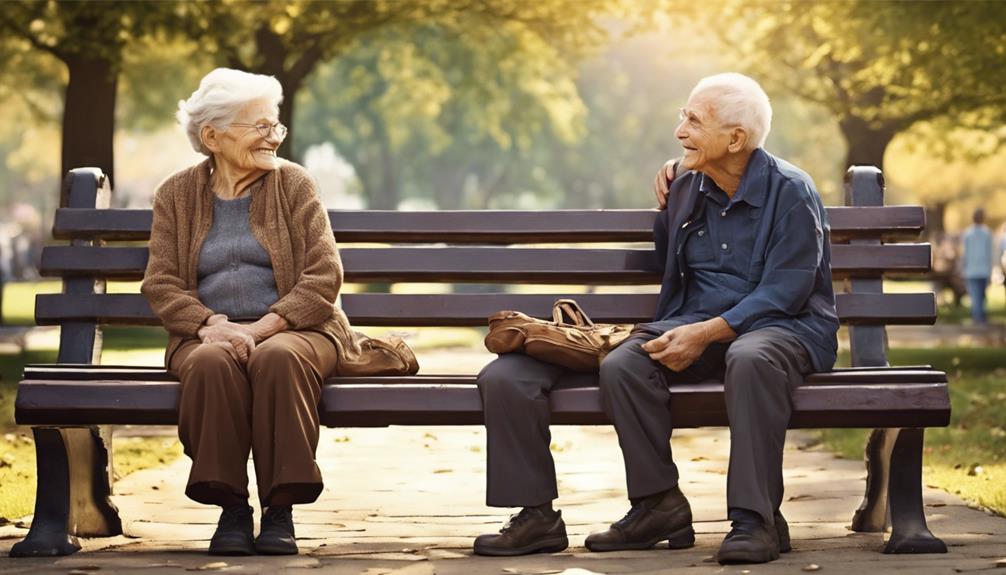
How can seniors effectively navigate the emotional challenges that arise after experiencing a fall? Emotional recovery after a fall can be a difficult journey, but with the support of loved ones and open communication, it's possible to rebuild independence and regain strength. Seniors may experience a fear of independent living after a fall, which can lead to a loss of self-confidence. To combat this fear, creating a safe and supportive environment during recovery is vital. Rearranging furniture to reduce the risk of additional falls can help boost confidence and promote a sense of security in the home.
Staying active post-fall is essential for rebuilding damaged self-confidence. Engaging in light exercises or activities recommended by healthcare professionals can aid in the emotional healing process. Encouraging open communication with family members and caregivers can provide the necessary support for seniors to express their feelings and fears. By fostering a supportive environment and maintaining open lines of communication, seniors can work towards emotional recovery and ultimately regain their independence.
Building Confidence Through Support
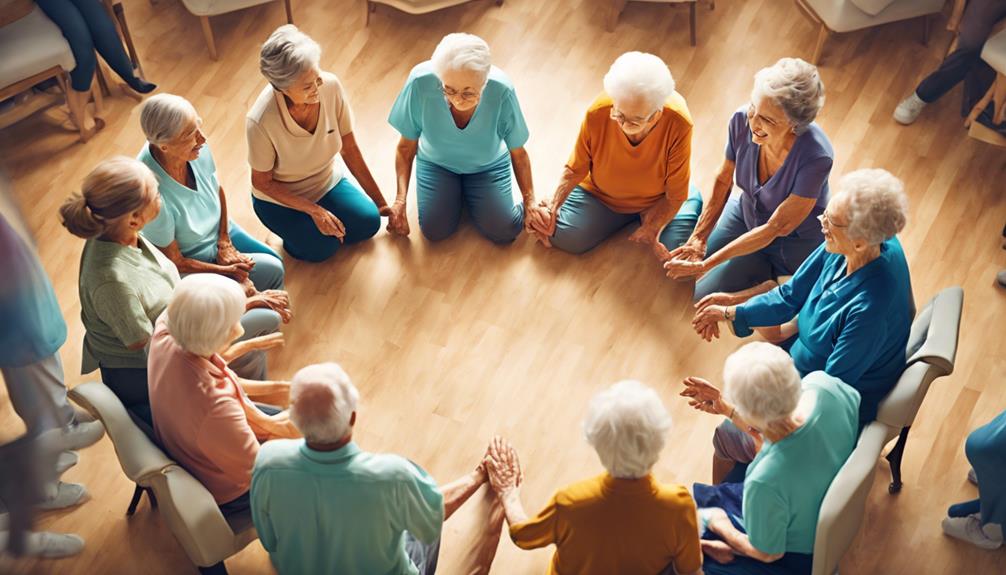
Building confidence through support involves encouraging community involvement and enhancing social connections.
By engaging with others in various activities, seniors can feel supported and motivated to overcome their fears of falling.
Strengthening bonds with caregivers, family members, and peers can provide a sense of security and help seniors rebuild their confidence post-fall.
Encouraging Community Involvement
To bolster seniors' confidence and sense of belonging, active participation in community engagements proves invaluable. Engaging in community involvement can combat feelings of isolation and loneliness, providing a sense of purpose and connection.
Here are some ways to encourage community involvement for seniors:
- Participate in group activities such as board games or movie nights.
- Utilize technology to connect with distant family members and friends.
- Attend family activities and events for emotional support and companionship.
- Join local clubs or organizations to meet new people and build relationships.
- Volunteer for community service projects to give back and stay active in society.
Enhancing Social Connections
Enhancing seniors' recovery from falls involves fostering strong social connections that provide essential support and encouragement. Social connections play a vital role in rebuilding confidence and overcoming feelings of isolation.
Seniors benefit greatly from engaging in social activities that offer companionship and understanding. Support from family, friends, and caregivers can greatly boost morale and motivation during the recovery process. By building these social connections, seniors can access emotional support and a sense of belonging.
Participating in group activities or outings not only enhances well-being but also provides opportunities for shared experiences. Creating a network of social support is key to instilling confidence and resilience in seniors as they navigate the challenges of fall recovery.
Nutrition and Recovery

Ensuring proper nutrition is a key component in seniors' recovery process following a fall. To support seniors in their journey to rebuild independence, here are essential nutrition tips:
- Protein Intake: Adequate protein intake is essential for muscle repair and strength building, aiding in the recovery process.
- Nutrient-Rich Foods: Consuming foods rich in nutrients can promote healing and contribute to overall well-being.
- Hydration: Staying hydrated is important for seniors' recovery as it not only supports the healing process but also helps prevent future falls.
- Balanced Diet: A balanced diet containing a variety of vitamins and minerals is essential for supporting the body's healing mechanisms.
- Consultation: Seeking guidance from a healthcare provider or a nutritionist can help tailor a nutrition plan that aligns with individual recovery needs.
Long-term Fall Prevention Strategies
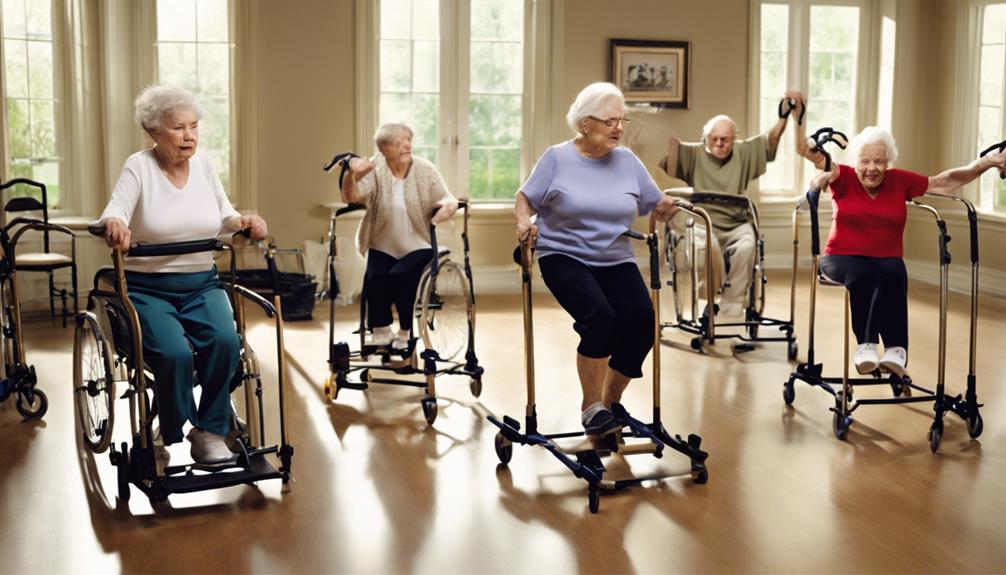
Improving balance, muscle strength, and eye-tracking ability through exercises is essential for long-term fall prevention strategies, especially for seniors looking to enhance their independence post-fall.
Engaging in regular physical activity, such as physical therapy sessions tailored to enhance balance and stability, can greatly aid in the recovery process.
Alongside exercise, creating a safe living environment is important. This involves simple adjustments like rearranging furniture to clear pathways, installing grab bars in bathrooms, and ensuring proper lighting throughout the home.
Encouraging the use of assistive devices like canes or walkers can provide added stability and reduce the risk of falls.
Taking proactive measures such as reviewing medications for side effects that may affect balance, staying active, and maintaining a clutter-free living space are essential for preventing future falls.
Frequently Asked Questions
How Do You Help a Senior Recover From a Fall?
We encourage seniors to engage in physical therapy, create a safe living environment, and stay active to rebuild self-confidence post-fall. Engaging in balance, strength, and eye-tracking exercises is essential. Providing emotional support throughout their recovery journey is indispensable. Additionally, incorporating tools like the best walkin tubs for elderly can significantly enhance safety during daily routines, reducing the risk of future falls. These tubs offer both comfort and security, making bathing easier and more accessible. Ultimately, promoting a combination of physical care, emotional support, and practical safety measures is key to a successful recovery.
How Long Does It Take for an Elderly Person to Recover From a Fall?
We acknowledge the concern about recovery time after a fall. Depending on the injury's severity and overall health, it may take several weeks to months. Physical therapy, a safe environment, and caregiver support expedite the process.
What Is the Best Way for Elderly to Get up From a Fall?
We should remember to avoid rushing to stand up after a fall. It's best to assess for pain, then try rolling onto hands and knees before crawling to furniture for support. Using nearby objects can help with balance.
What Are the Steps Involved in a Fall Recovery?
We focus on immediate medical attention, engaging in physical therapy, addressing environmental factors, developing a personalized safety plan, and seeking emotional support during fall recovery. These steps are essential for regaining independence and preventing future incidents.
Conclusion
To sum up, seniors can rebuild their independence after a fall by addressing common risk factors, overcoming fear, and taking steps to prevent falls at home.
By staying active, following a home safety checklist, and seeking emotional support, seniors can regain confidence and improve their overall well-being.
Remember, recovery is a journey, not a destination, so take one step at a time and never give up.
As the saying goes, 'fall seven times, stand up eight.'


